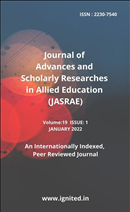Synthesis of Novel Complexes with Interaction of Ligand and Metal Ions Such as Mn (II), Fe (III), Co (II), Ni (II) and Cu (II)
Keywords:
Transition Metal Complex, 1,3,4-Thiadiazole, Salicylaldehyde, Schiff Base and ComplexesAbstract
Sulfuric acid and a Compounds of cobalt, nickel, copper, cadmium, and iron have been created by combining a Schiff base obtained from 2-amino-5-(2-amino-1,3,4-thiadiazolyl)-1,3,4-thiadiazole (1). The ligand and its complexes have been analyzed using techniques such as infrared and 1H nuclear magnetic resonance spectra, elemental investigations, The techniques used include ultraviolet-visible spectroscopy and discrepancy current investigation using thermogravimetry (TGA-DTA). Analytical data shows that the metal-to-ligand proportion in Cu (II) complexes is 2:2, but in Co (II), Ni(II), Cd(II), and Fe(II) complexes, it is 1:2. N- [5' -Amino-2,2' -bis(1,3,4-thiadiazole)-5-yl] is the chemical name of the substance. With the exception of Ni (II) and Cu (II), the predicted structures for the formation of Fe (II), Co (II), and Cd (II) are octahedral, tetrahedral, and square-planar features, respectively. The synthesis of novel Two distinct ligands, Benzaldehyde with two carbon and hydrogen bonds Cobalt (II), nickel (II), copper (II), and zinc (II) were among the metallic compounds reacted with Benzaldehyde picolinoyl hydrazine (CBPH) and 4-methylbenzoylhydrazone (CBMH) are two examples. This reaction led to the formation of metal complexes. Condensation reactions using Hydrazide, 2-carboxy benzaldehyde, 4-methylbenzoyl, and picolinoyl estersindividually, were used to produce CBMH and CBPH. [M(L-H)2] complexes are genuine. The characterization of xH2O was performed using spectral measurements, including UV-Vis, IR, molar conductance, and chemical analysis. All the complexes involving the hydrazones CBMH and CBPH have the ligand function, exhibiting monobasic tridentate characteristics.
References
Jevtovic V, Alshamari Ak, Milenković D, Dimitrić Marković J, Marković Z, Dimić D. The effect of metal ions (Fe, Co, Ni, And Cu) on the Molecular-Structural, Protein Binding, And Cytotoxic Properties of Metal Pyridoxal-Thiosemicarbazone Complexes. Int j mol sci. July 25;24(15):11910. Doi: 10.3390/ijms241511910. Pmid: 37569285; pmcid: pmc10419307.
Ma. El-ghamry (2016).Synthesis of Co(II), Ni(II), Cu(II), Fe(III), vo2+ and uo2+Complexes Derived From A New Bis(Pyridylurea) Ligand. Spectroscopic characterization, thermal, magnetic and 3d molecular modeling studies,” ijpcbs 2016, 6(1), 76-96 ma el-ghamry et al. Issn: 2249-9504
Lidia zapała (2021).Green Synthesis Of Niflumic Acid Complexes with Some Transition Metal Ions (Mn(II), Fe(III), Co(II), Ni(II), Cu(II) and Zn(II)). Spectroscopic, thermoanalytical and antibacterial studies,” thermochimica actavolume 696, February 2021, 178814
Tas, E.&Kilic, Ahmet & Durgun, Mustafa & Küpecik, L.& Yilmaz, I.& Arslan, Sonmez. (2010). Cu(II), Co(II), Ni(II), Mn(II), and Fe(II) metal complexes containing N,N'-(3,4-diaminobenzophenon)-3,5-Bu-2(t)-salicylaldimine ligand: synthesis, structural characterization, thermal properties, electrochemistry, and Spectro electrochemistry. Spectrochimica acta. Part a, molecular and biomolecular spectroscopy. 75. 811-8. 10.1016/j.saa.2009.12.002.
Soleimani, Esmaiel. (2010). Novel complexes of Mn(II), Co(II), and Cu(II) with ligand derived from dibromobenziloxime. Journal of the Chinese chemical society. 57. 10.1002/jccs.201000091.
Suvarapu, L. N., Seo, Y. K., Baek, S. O., & Ammireddy, V. R. (2012). Review on analytical and biological applications of hydrazones and their metal complexes. E-Journal of Chemistry, 9(3), 1288-1304.
Rollas, Sevim, and S Güniz Küçükgüzel. “Biological activities of hydrazone derivatives.” Molecules (Basel, Switzerland) vol. 12,8 1910-39. 17 Aug. 2007, doi:10.3390/12081910.
Verma, G., Marella, A., Shaquiquzzaman, M., Akhtar, M., Ali, M. R., & Alam, M. M. (2014). A review exploring biological activities of hydrazones. Journal of pharmacy & bioallied sciences, 6(2), 69-80. doi:10.4103/0975-7406.129170.
Jing-lin, W., Ya-qin, Z., & Bin-sheng, Y. (2014). Transition metal complexes of asymmetrical aroylhydrazone ligand: Syntheses, structures, DNA binding and cleavage studies. Inorganica Chimica Acta, 409, 484-496.
Aly, S. A., & Fathalla, S. K. (2020). Preparation, characterization of some transition metal complexes of hydrazone derivatives and their antibacterial and antioxidant activities. Arabian Journal of Chemistry, 13(2), 3735-3750.








